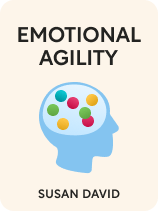

This article is an excerpt from the Shortform book guide to "Emotional Agility" by Susan David. Shortform has the world's best summaries and analyses of books you should be reading.
Like this article? Sign up for a free trial here.
Do you tend to bottle emotions or brood in them? Do you believe narratives that simply aren’t true?
Susan David’s Emotional Agility: Get Unstuck, Embrace Change, and Thrive in Work and Life explains that most people react instinctively to the way they perceive events. And, these perceptions are based on emotional, often-untrue narratives explaining why those events took place.
Continue reading for an overview of this book that can help you get unstuck and move on in life.
Overview of Emotional Agility by Susan David
When you experience a negative or stressful event, do you think through your responses carefully and act exactly as you want to? Or do you find yourself caught up in the emotions of the moment, acting in ways that you later feel embarrassed or ashamed of? Are your emotions knee-jerk reactions that you can’t seem to control?
Susan David’s Emotional Agility: Get Unstuck, Embrace Change, and Thrive in Work and Life (2016) contends that people often react in ways that don’t match the practical needs of the moment—like blowing up over their spouse’s simple mistake—and don’t align with their values, the things most important to them in life. This is because they’re driven by their narratives.
David—a clinical psychologist and management consultant—argues that you can break free of your controlling narratives through emotional agility, the skill of seeing events and your emotions objectively. It allows you to choose your responses—rather than reacting based on emotion-driven instincts—and thereby manage negative events with calm clarity. You’ll live more intentionally within your values.
(Shortform note: While David focuses almost exclusively on the control negative emotions have over you, it’s important to consider how positive emotions control you, too. Research suggests that emotions usually seen as positive can also negatively impact your choices. For example, optimism can make you more likely to take risks—for example, a feeling of optimistic excitement at the casino may drive you to spend much more money than you’d intended. Consider how emotional agility’s principles can apply to both the negative and positive emotions that control your behavior.)
We’ll cover David’s ideas in three parts:
- Part 1: The Controlling Power of Narratives explains what narratives are and how common methods of dealing with them negatively impact your life.
- Part 2: Developing Emotional Agility details how you can replace your controlling narratives with an objective perspective on your emotions and the events in your life. This will give you the freedom to respond deliberately to events, rather than reacting instinctively.
- Part 3: Living Your Life to the Fullest Through Emotional Agility covers how you can live in alignment with your values when your narratives no longer control you.
Part 1: The Controlling Power of Narratives
Your brain is programmed to take in sensory information and interpret it through narratives explaining how and why the world works. David explains that people instinctively believe these narratives are true because they’re informed by emotions, which we’re wired to pay attention to. Emotions serve the evolutionary purpose of creating a physiological reaction in your body in response to external stimuli. You may not need to run from danger like your ancestors, but your brain is still neurochemically wired to react to emotions—and their associated narratives.
If you’re walking home at night and consider using a long, unlit street for a shortcut, your brain might draw upon a narrative that dark streets are dangerous. Your brain also gives you sweaty palms and a feeling of dread to encourage you to listen and avoid the shortcut.
When Narratives Don’t Help You
Your brain often makes mistakes when interpreting meaning from sensory information—and, because it relies on these faulty interpretations to form narratives, the narratives it creates don’t always reflect objective reality.
For example, a middle schooler might fail a test because he played video games instead of studying. His parents express disappointment at his priorities—which the student’s brain misinterprets as anger at his failure. He forms the narrative, “If I fail at school, my parents will hate me.” As the student grows older, he views professional life through the old narrative’s lens: “If I fail in my work project, my boss will hate me.” This leads to an unfounded fear of his boss, anxiety over failure, and risk aversion.
Narratives deliver information through an internal stream of consciousness that constantly fills your mind with thoughts, associated memories, and emotions. When you reflect on these thoughts, this inner voice also drives you to judge yourself through the lens of your narratives. David says these self-judgments create emotions of inadequacy and frustration.
For example, if you experience a setback at work, your inner voice might whisper that you’ll never succeed—prompting shame and self-loathing. If you instinctively believe and act according to this narrative and these emotions, you might avoid risks that could lead to growth and fulfillment.
Unhealthy Responses to Your Controlling Narratives
When you feel negative emotions about an event, past or present, you may be tempted to use one of two common—but unhelpful—methods to deal with the pain: bottling and brooding. We’ll explore each method and explain David’s reasoning for why both methods fail.
Bottlers
Bottlers attempt to avoid feeling or acknowledging negative emotions that arise from their narratives. They believe only weak people are affected by emotions and choose to reject them. David explains that you can ignore your emotions temporarily, but they’ll grow stronger as you push them away—until they eventually explode. For example, after many months of bottling hurt at your spouse’s tendency to forget important events, you unexpectedly blow up at them for forgetting to pick up garlic at the store as you asked.
Moreover, Bottlers miss out on the ways emotions can be valuable. Remember that your emotions not only help you avoid danger, but they can also allow you to thrive. For example, working a dead-end job might frustrate you because you believe the narrative that you deserve more fulfilling work. Bottling that frustration so that you don’t feel daily discomfort can also leave you unmotivated to find something better.
Brooders
Brooders ruminate on their narratives and negative emotions rather than bottling them. They often fixate on past negative experiences, repeatedly reliving the emotions associated with those events. These emotions and experiences can range from traumatic (hating a drunk driver who caused your long-term injury) to annoying (complaining to your spouse about a coworker’s irritating habit). David says that those who brood in one area likely do so in many other areas of life, using brooding as a general approach to handling negative emotions.
David says that Brooders often believe they’re working through their emotions in a healthy way by thinking about them over and over. However, the strategy of brooding never moves past an eternal loop of “think about it some more,” which only intensifies the negative emotions and takes up mental space you could otherwise use to improve your life. Without a way to move on from painful emotions, merely thinking about them can’t free you from them.
Part 2: Developing Emotional Agility
The good news is that you don’t have to let your narratives—or your emotional responses to them—control you. Instead, David advocates cultivating the skill of emotional agility—viewing events and emotions objectively and responding deliberately.
David describes four steps for developing emotional agility:
- Label your emotions.
- Accept your emotions.
- View your emotions objectively.
- Choose your values.
Let’s explore each step in detail.
Step 1: Label Your Emotions
The first step to achieving emotional agility is labeling your emotions—that is, using honest, specific language to describe what you’re feeling. David argues that the combination of honesty and specificity forces you to understand the exact nature of your emotions, no matter how uncomfortable. Otherwise, you might feel tempted to ignore them or to use vague words to avoid painful vulnerability.
For example, you might carry a decades-old burden of shame for never completing your education. You’ve previously talked about these feelings in a way that lacks specificity: “I wish I’d ‘done things differently’ in life.” Based on this generality, you think a career change will make you feel better—but this doesn’t address your feelings of shame and therefore doesn’t help. On the other hand, labeling your emotions precisely might mean saying, “For decades, I’ve regretted dropping out of college. I’ve felt shame for failing and wasting my parents’ money. Every day since then, I feel sick at the mention of school or career growth.”
Step 2: Accept Your Emotions
Once you’ve labeled your emotions, you can begin the second step of developing emotional agility: accepting your emotions. This means compassionately giving yourself permission to feel, struggle, and fail. You’ll acknowledge that neither the act of feeling unwanted emotions—particularly guilt and shame—nor the act of believing inaccurate narratives make you less of a person.
To achieve acceptance and self-compassion, David encourages you to look at your own faults and flaws as you would those of a loved one or a young child—with forgiveness. This strips away the accusatory power that self-narratives often hold.
In our example of feeling guilty about dropping out of college, you might be telling yourself that failing in the past makes you a failure. Self-compassion in this case might mean saying, “I regret my past decision, but I can still learn from it and make different choices in the future.” You acknowledge your past mistakes without believing the lie that you should feel guilt or shame forever.
David notes that accepting your emotions can help you use them for their evolutionary purpose: prompting behaviors that can improve your life. Regret from dropping out of college might prompt reflection and planning for a return to school or an attempt at moving up in your career—without the fear that you’re a failure who’ll never succeed in new ventures.
Step 3: View Your Emotions Objectively
Labeling and accepting your emotions goes a long way to reducing their intensity and power over you—which makes it easier to take the third step of developing emotional agility: viewing your emotions from an objective perspective. David says that, when you’re able to look at your emotions—and the narratives they come from—from a rational, objective standpoint, you’ll be able to see the flaws in your narrative and in your emotional reactions to it.
For example, if someone cuts you off in traffic, you might feel anger as your brain forms the narrative, “He deliberately cut in front of me!” For the rest of your commute, you brood in your anger. However, if you think about the situation objectively, you’ll realize that the other driver likely wasn’t trying to mistreat you—he simply didn’t see you—and there’s no reason to be so angry.
Additionally, understanding that your emotions are temporary experiences, not absolute truths about your life helps lessen the power of the narratives you hold about yourself. For example, the fact that you feel sad in reaction to an event doesn’t mean you can’t handle stress or that your situation is hopeless. It only means that, at that moment, you feel sad.
David offers two techniques for gaining an objective perspective: mindfulness for handling your present emotions and journaling for handling your past emotions.
Handle Present Emotions With Mindfulness
Mindfulness is the act of paying attention to your senses, emotions, and surroundings without judgment. David suggests that, by paying attention to the stimuli in your surroundings—and the emotions that arise from your thoughts about these stimuli—you can weaken your instinct to believe your narratives. Your brain avoids mindfulness to save you mental energy in everyday life: If you can pour a glass of water without paying close attention, you’ll likely do so on autopilot every time you’re thirsty. While on autopilot in this way, you’re more susceptible to your narratives and emotions controlling you.
However, David says you don’t need to be mindful at every moment in order to ward against narrative and emotional control. Instead, pay deliberate attention to your surrounding stimuli from time to time throughout the day. You’ll gradually become more mindful with practice.
Handle Past Emotions With Journaling
Journaling means writing down your experiences, feelings, and thoughts—or narrating them into a voice recorder. Unlike mindfulness, which deals with present emotions, journaling is a technique for processing past emotions and narratives. David says journaling naturally leads you to label and accept your emotions, offering you a more objective understanding of those emotions. Journaling can reduce the power of lifelong emotions and narratives, preparing you to actively choose your responses to emotions in the future.
Step 4: Choose Your Values
Now that you’ve learned how to take back control from your narratives and emotions, you can move on to the final step of developing emotional agility: choosing your values. Values are the guiding principles that shape your behaviors and decisions, the things in life that you believe are most important. David explains that everyone has values, whether they realize it or not—though for most people, many of these values are intrinsically tied to unconscious narratives.
For example, your extended family might consider “family” a core value—and look down on you for cutting an abusive parent out of your life. You might then feel tempted to believe the narrative that you must always remain in contact with your family, no matter what.
David recommends contemplating the values others impose on you. Examine your behavior across different settings in your life. Do you act or speak differently around friends, family, and others? If so, why? Does this arise from a desire to appease or impress others who value certain behaviors more than you do?
Choose and Pursue Your Personal Values
David says that, besides the values you receive from others, you also carry a set of personal, unique values that, when pursued, will give you a sense of fulfillment and purpose. When you objectively understand your emotions, you don’t instinctively believe what your narratives and emotions say you should value. You’re free to purposely determine—and live by—your personal values.
David gives advice on how to determine your values: Ask yourself what life you’d pursue if you had no obstacles or stress standing in your way. When you go to bed each night, think over your day and decide what parts of it were valuable and which didn’t feel fulfilling. Imagine what your future self might think of your current values—and where those values will lead you in the future.
Part 3: Pursuing the Life You Want
Even after you develop the skill of emotional agility, your past still affects you—a past shaped by narratively and emotionally driven decisions. Changing the life you spent years building according to your narratives won’t be easy, but living by a couple of David’s principles will put you on the right path:
- Grow through gradual change.
- Live for the future, not the past.
We’ll explain how these principles can help you start living by your values while avoiding falling back into the trap of narrative and emotional control.
Principle #1: Grow Through Gradual Change
Though emotional agility gives you techniques to choose how you act and respond to events in your life, shifting from living by your narratives to living by your values involves making many small, deliberate choices every day that serve your values.
Studies show that setting small goals for change is more likely to result in success than committing to huge, life-changing goals all at once. When your goals are smaller, the stakes for failure are lower. David says that because you won’t be held back by emotions that often accompany failure, like fear of shame or embarrassment, you’ll be more likely to succeed.
David emphasizes three avenues for successful, gradual change: your belief in your abilities, your attitude toward change, and your routines. Let’s explore each in detail.
Avenue 1: Your Belief in Your Abilities
To escape controlling narratives of fear and helplessness, David urges you to choose to believe that you’re capable of change and growth. Studies show that you’re more likely to succeed in your goals for change when you believe that capacity is within your power.
However, David doesn’t advise simply believing you will succeed at every goal regardless of its scope or the obstacles that stand in your way. Instead, she suggests approaching low-stakes goals with the belief that you will succeed. Over time, you’ll build a new narrative that you’re truly capable of success.
Avenue 2: Your Attitude Toward Change
The work of pursuing your goals—spending hours job hunting, for example—can feel like an unpleasant chore. This can make you less likely to follow through with your goals in the long term. To combat this frustration, reframe your responsibilities and tasks as things you genuinely want to do—and as stepping stones toward goals that you also want to achieve.
David says you’re more likely to feel motivated and committed in the long term when you approach tasks in this way.
Avenue 3: Your Routines
In addition to prompting your emotional reactions to narratives, your body and brain also drive you toward instinctive actions requiring little to no conscious thought: routines. When you repeatedly make the same desired choice—perhaps choosing fruit over candy if your value is “healthy eating”—that choice gradually becomes an instinctive routine.
David offers two ways to sculpt your routines to promote a gradual change that will serve your values:
1) Adjust your environment. Change how easily you can access things that help or hurt your values. If you want to journal instead of looking at your phone first thing in the morning, keep your journal by your bedside and leave your phone on a charger at the other end of the house.
2) Adjust an existing routine. It’s easier to change an existing routine than to create a new one, so a fairly simple way to add your values into your life is resolving to do a values-supporting behavior at the same time as a step in your routine. For example, if you want to show your partner you love her, you can add “write a caring note” to your current routine of preparing coffee.
David adds that if you habitually struggle with certain negative emotions, you can add the extra step of coming up with a positive response to your emotion. For example, if you frequently feel exasperated at your child’s behavior, you can tell yourself, “When I feel frustrated, I’ll stop, decide how I want to respond, and then answer.”
David warns you to stay aware and critical of your routines—even the new ones that serve your values. Falling too deeply into any routine puts you at risk of falling back into mindless behavior and automatic reactions.
Principle #2: Live for the Future, Not the Past
David warns against believing the sunk-cost fallacy when pursuing your goals. The sunk-cost fallacy is a narrative that insists you should continue pursuing a goal no matter what to avoid wasting the time, money, and other resources you’ve already spent pursuing it.
Perhaps you find your career unfulfilling. You might still feel reluctant to leave a position it took years to reach. Even if another career seems more satisfying, your narrative might provoke feelings of loyalty to your company, fear of the unknown, and perhaps even guilt at the idea of “wasting” years of your life.
The sunk-cost fallacy can be a difficult narrative and set of emotions to view objectively. Nevertheless, David urges you to consider an alternative perspective: Instead of considering what you’ve invested in a goal, consider what you stand to lose by continuing to pursue that goal. If you don’t change your situation, what opportunities might you miss? By acknowledging that keeping your current goals could mean wasting opportunities, you strip the sunk-cost fallacy of its controlling power.

———End of Preview———
Like what you just read? Read the rest of the world's best book summary and analysis of Susan David's "Emotional Agility" at Shortform.
Here's what you'll find in our full Emotional Agility summary:
- Why most people react instinctively rather than objectively
- How to live according to your values to create the life you want
- How to handle your emotions better using mindfulness techniques






